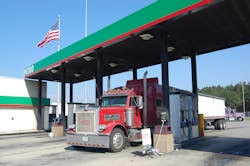Fuel prices are now at their highest level since 2014, and industry experts see that upward trend continuing. SONAR data shows the average price of diesel at truck stops is $3.15 a gallon; this is slightly below the 10-year average of $3.15 reported by the American Transportation Research Institute.
Because of the various factors that go into fuel pricing, it is difficult to predict with certainty whether diesel prices will stay where they are, go higher or come down.
But the fact is the trucking industry is seeing higher prices right now and, since fuel is the number one cost for most fleets, getting more out of a gallon of diesel should be a priority.
Doing that is not simply a matter of buying fuel smarter, although that certainly plays a role. Managing fuel spend is the result of a number of factors.
It all starts with the way the truck is spec’d. Bigger is not always better when it comes to spec’ing. Truck size and engine displacement all need to be considered. The goal is to right size your fleet, which means having enough of the right kinds of trucks that allow you to make deliveries in the most efficient manner.
Technology is your friend when it comes to improving MPG. Things like adding aerodynamic devices, tire pressure monitoring/inflation systems and devices that allow the driver to avoid idling all add up to less fuel used.
Once you have the truck spec’d properly, spend some time tweaking the electronic engine parameters so they are best fitted for your operation. A 5-8% improvement in fuel economy is possible for fleets that optimize their engine parameters for fuel economy, according the North American Council For Freight Efficiency.
Even with all the automation on newer trucks, drivers still can have as much as a 20% impact on fuel economy. Teaching your drivers the best way to operate their vehicles — including using cruise control, driving slowly, etc. — can make a difference in the amount of fuel used. You can also incentivize drivers based on fuel consumption, percentage idle, etc.
If it’s been some time since you’ve completed a routing analysis, consider undertaking one. There are software tools that can help you determine if you are selecting the most efficient routes for your trucks. Look at things like out of route miles and empty back hauls to see if you can reduce them.
These tips will help you get more from a gallon of diesel and that is a good thing no matter what fuel costs, or even which fuel you use.
About the Author
Jane Clark
Senior VP of Operations
Jane Clark is the senior vice president of operations for NationaLease. Prior to joining NationaLease, Jane served as the area vice president for Randstad, one of the nation’s largest recruitment agencies, and before that, she served in management posts with QPS Companies, Pro Staff, and Manpower, Inc.
